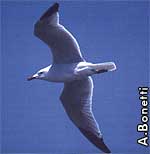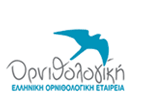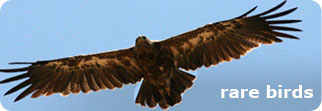Audouin's Gull (Larus audouinii) is the only gull occurring only in the Mediterranean. At a first glance, it looks like a common species of gull, Yellow-legged Gull (Larus cachinnans), having a white body and grey wings with black tips. However, it is a bit smaller (50 cm), its bill is red, its feet are dark and on air it is slimmer and more delicate.
Like most seabirds, our knowledge for Audouin's Gull is focused around breeding period. Breeding populations have been recorded in Algeria, Cyprus, France, Greece, Italy, Morocco, Spain, Tunisia and Turkey. Nesting sites of the species vary, but most of them are located in isolated sparsely vegetated islets.
Audouin's Gulls appear at nesting sites from late March to early April. They lay 2-3 eggs and their incubation lasts for three weeks. Eggs are hatched in mid May and nestlings remain in nest for a few days. Juveniles, having a brown-grey plumage, fledge after 30-35 days and from mid July, adult and juvenile birds, abandon the colony. At winter, the species spreads mainly on the southern and eastern coasts of the Mediterranean.
It feeds near the coasts, mainly on small surface-fish that are caught on the surface using a very skilled technique, flying low and slowly over water. Birds in W Mediterranean feed mainly on fish discarded by trawlers.
In the past, Audouin's Gull was rarer, its numbers however have been increased and its present population is estimated to be 18,700 pairs.  This sudden increase is mainly due to the great availability of food in western Mediterranean. Nevertheless, the species is considered to be vulnerable because 90% of its population is concentrated in two colonies in Spain (Ebro River Delta and Chafarinas Islands). So, Audouin's Gull is characterized from BirdLife Inernational as a "protection-dependant" species and is recorded as "endangered" on the Greek Red Book of Threatened Vertebrates. It is also included in Appendix I of 79/409/EEC Directive for the protection of birds, in Appendix II of Bern Convention and in Appendix I of Bonn Convention.
This sudden increase is mainly due to the great availability of food in western Mediterranean. Nevertheless, the species is considered to be vulnerable because 90% of its population is concentrated in two colonies in Spain (Ebro River Delta and Chafarinas Islands). So, Audouin's Gull is characterized from BirdLife Inernational as a "protection-dependant" species and is recorded as "endangered" on the Greek Red Book of Threatened Vertebrates. It is also included in Appendix I of 79/409/EEC Directive for the protection of birds, in Appendix II of Bern Convention and in Appendix I of Bonn Convention.
The main threat for this bird is related to the disturbance of the breeding birds from the presence of man on the islets, something connected with activities as cattle raising, tourism, fishery, hunting and maintenance and construction of infrastructures.
Another threat is the reduction of fishing stocks available for birds, drowning in fishing tools, sea pollution and predation. Competition with Yellow-legged Gull for food and nesting sites also seems to have a negative impact on the species, as well as the alteration of the natural morphology of the islets, due to overgrazing.
Since 1997, HOS has been conducting a triennial LIFE program for the protection of Audouin's Gull, which includes instant actions and the preparation of management proposals for six sites of Natura 2000 network in which the species occurs. A direct goal is the reduction of disturbance in the breeding colonies through guarding, research of the breeding activity of the birds and monitoring of human presence.
Actions have also been made in order to prevent herds from approaching the colonies (dry-stone wall building and re-allocation of sheep and goats). At the same time, a program for the sensitization and information of local authorities, residents and tourists is being conducted through meetings, leaflets and the installation of two information centers.
After a year’s work, it is estimated that approximately 600 pairs breed in 20 scattered colonies in Greece, the biggest population in the Eastern Mediterranean. HOS’ goal is to extend its actions and research in all the areas where Audouin's Gulls occur, in order to protect the unique nature of the Aegean.


 This sudden increase is mainly due to the great availability of food in western Mediterranean. Nevertheless, the species is considered to be vulnerable because 90% of its population is concentrated in two colonies in Spain (Ebro River Delta and Chafarinas Islands). So, Audouin's Gull is characterized from BirdLife Inernational as a "protection-dependant" species and is recorded as "endangered" on the Greek Red Book of Threatened Vertebrates. It is also included in Appendix I of
This sudden increase is mainly due to the great availability of food in western Mediterranean. Nevertheless, the species is considered to be vulnerable because 90% of its population is concentrated in two colonies in Spain (Ebro River Delta and Chafarinas Islands). So, Audouin's Gull is characterized from BirdLife Inernational as a "protection-dependant" species and is recorded as "endangered" on the Greek Red Book of Threatened Vertebrates. It is also included in Appendix I of 
